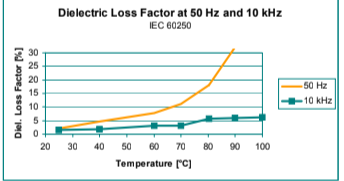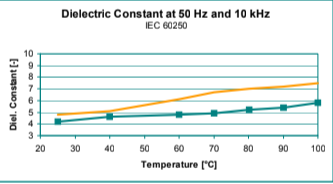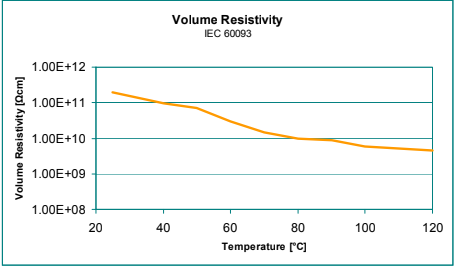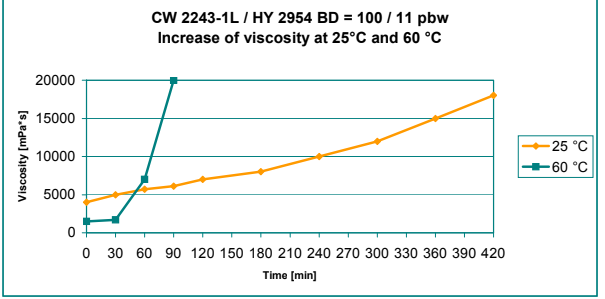Enhanced TDS
Identification & Functionality
- Chemical Family
- RTU Product Type
- Technologies
- Product Families
Features & Benefits
- Ready-to-Use Product Features
- Product Features
- Low viscosity
- Long pot Life
- High flexibility after cure
- Very good thermal aging resistance
Applications & Uses
- Composites Processing Methods
- Processing Methods
Casting; vacuum casting
- Processing Information
Preparation
- ARALDITE® CW 2243-1 L contains fillers, which tend to settle over time. It is therefore recommended to carefully homogenize the complete contents of the container before use.
- In the storage vessels of the production equipment, the pre-filled products should be stirred up from time to time to avoid sedimentation and irregular metering.
Mixing
- The casting mix is best prepared by heating the resin up to 40 – 50 °C before stirring in the hardener.
- Brief degassing of the mix under 5 – 10 mbar vacuum improves the mixture homogeneity and enhances the dielectric properties of the castings.
Curing
- To determine whether cross-linking has been carried to completion and the final properties are optimal, it is necessary to carry out relevant measurements on the actual object or to measure the glass transition temperature.
- Different gel and cure cycles in the customer’s manufacturing process could lead to a different degree of cross- linking and thus a different glass transition temperature.
Regulatory & Compliance
- Certifications & Compliance
Technical Details & Test Data
- Mechanical & Physical Properties
Condition : at 23°C. Cured for 24h/RT + 6h/60°C
Property Value Unit Test method Color of Casting Natural beige - - Density 1.57 g/cm³ ISO 1183 Glass transition temperature ca. 42 °C ISO 11357-2 Max. service temperature Class B - IEC 60085 Tensile strength 30 MPa ISO 527 Elongation at break 3.9 % ISO 527 Elastic Modulus 3,550 MPa ISO 527 Flexural Strength 61 MPa ISO 178 Elongation at break (Flexural) 3.4 % ISO 178 Elastic Modulus (Flexural) 3450 MPa ISO 178 Critical stress intensity factor (KIC) 1.46 MPa·m¹/₂ Double Torsion Test
Specific energy at break (GIC) 560 J/m² Double Torsion Test
Hardness 80 Shore D DIN 53505 Flammability V-0 (6 mm) - UL 94 Water absorption (10 days at 23°C) 0.82 % by wt. ISO 62/80 Water absorption (30 min at 100°C) 0.43 % by wt. ISO 62/80 - Electrical Properties
Condition : at 23°C. Cured for 24h/RT + 6h/60°C
Property Value Unit Test method Dielectric strength (3 mm specimen) 21 kV/mm IEC 60243-1 Dielectric loss factor (tan δ, 50Hz, 25°C) 2 % IEC 60250 Dielectric constant (εr, 50Hz, 25°C) 4.8 - IEC 60250 Volume resistivity (ρ, 25°C) 2 x 10¹¹ Ω·cm IEC 60093 Electrolytic corrosion A-1 - IEC 60426 Tracking resistance (CTI) > 600 M-0.1 IEC 60112 Dielectric Loss Factor :

Dielectric Constant :

Volume Resistivity :

- Processing Guidelines

Safety & Health
- First Aid
- Contamination of the eyes by resin, hardener or casting mix should be treated immediately by flushing with clean, running water for 10 to 15 minutes. A doctor should then be consulted.
- Material smeared or splashed on the skin should be dabbed off, and the contaminated area then washed and treated with a cleansing cream (see above). A doctor should be consulted in the event of severe irritation or burns. Contaminated clothing should be changed immediately.
- Anyone taken ill after inhaling vapours should be moved out of doors immediately. In all cases of doubt call for medical assistance.
- Handling Precautions
protective clothing yes gloves essential arm protectors recommended when skin contact likely
goggles/safety glasses yes respirator/dust mask recommended Skin protection Apply barrier cream to exposed skin.
before starting work Apply barrier or nourishing cream.
after washing Dab off with absorbent paper, wash with
Cleansing of contaminated skin warm water and alkali-free soap, then dry with disposable towels. Do not use solvents.
Clean shop requirements Cover workbenches, etc. with light coloured paper. Use disposable breakers, etc.
Disposal of spillage Soak up with sawdust or cotton waste and deposit in plastic-lined bin.
Ventilation: of workshop Renew air 3 to 5 times an hour.
of workplace Exhaust fans. Operatives should avoid inhaling vapours.
- Industrial Hygiene
Mandatory and recommended industrial hygiene procedures should be followed whenever our products are being handled and processed.
Storage & Handling
- Storage Conditions
- Store the components in a dry place at 18-25°C, in tightly sealed original containers.
- Under these conditions, the shelf life will correspond to the expiry date stated on the label.
- After this date, the product may be processed only after reanalysis.
- Partly emptied containers should be tightly closed immediately after use.
Other
- Application Information
Value Units Test Method / Conditions Mix Ratio 0.11 %(W) %(W) Hardener : Resin
